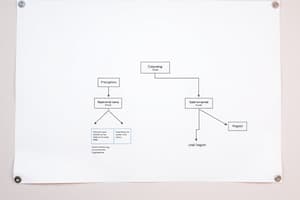Podcast
Questions and Answers
What is a class diagram in UML?
What is a class diagram in UML?
A type of static structure diagram that describes the structure of a system by showing the system's classes, attributes, operations, and relationships among objects.
What do class diagrams provide in the software development lifecycle?
What do class diagrams provide in the software development lifecycle?
- Step-by-step coding instructions
- High-level overview of a system's design (correct)
- Database schema definitions
- Detailed user interface prototypes
What are attributes in a class diagram?
What are attributes in a class diagram?
Data members of the class that represent the characteristics or properties of the object.
What are methods in a class diagram?
What are methods in a class diagram?
Which visibility notation indicates public access in a class diagram?
Which visibility notation indicates public access in a class diagram?
Class diagrams cannot be used during the implementation phase of software development.
Class diagrams cannot be used during the implementation phase of software development.
In a class diagram, methods are known as ______.
In a class diagram, methods are known as ______.
Flashcards are hidden until you start studying
Study Notes
Class Diagrams - Introduction
- A class diagram in UML is a static structure diagram that describes the structure of a system by showing its classes, attributes, operations, and relationships.
- Class diagrams are used in object-oriented programming to represent classes, and the relationships between them.
- They can be directly mapped with object-oriented languages.
- Classes are depicted as boxes, containing class name, attributes, and methods.
- They provide a high-level overview of a system's design, helping to communicate and document the software structure.
Purpose of Class Diagrams
- They are fundamental tools in object-oriented design.
- They are used for analysis, design, and implementation phases of a software development cycle.
Class Diagram: Analysis and Design
- Used in the analysis stage, a class diagram helps understand the requirements and identify components.
- In object-oriented projects, class diagrams created early contain classes that often translate into actual software classes.
- They are refined over time to represent specific system parts, user interfaces, logical implementations, and more.
- They provide a snapshot of the system's workings, including relationships between components at various levels.
- Class diagrams visualize, specify, and document structural features in models.
- They help convert models into code and vice-versa.
Class Diagram: Useful Functions
- Capture and define the structure of classes and other classifiers.
- Define relationships between classes and classifiers.
- Illustrate model structure using attributes, operations, and signals.
- Show common classifier roles and responsibilities that define system behavior.
- Show implementation classes within a package.
- Show the structure and behavior of one or more classes.
- Show inheritance hierarchies among classes and classifiers.
- Show workers and entities as business object models.
Class Diagram: Elements
- Class Name: Typically centered and bold in the top compartment of the class box.
- Attributes: Represent data members of the class, listed in the second compartment, often with visibility (public, private) and data type.
- Methods: Represent the behavior or functionality. Listed in the third compartment, with visibility, return type, and parameters.
Visibility Notation
- + for public (visible from all classes).
- - for private (visible only within the class).
- # for protected (visible to subclasses).
- ~ for package or default visibility (visible to classes in the same package).
Studying That Suits You
Use AI to generate personalized quizzes and flashcards to suit your learning preferences.




